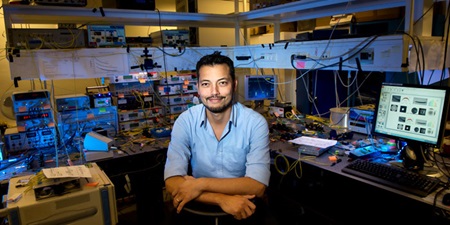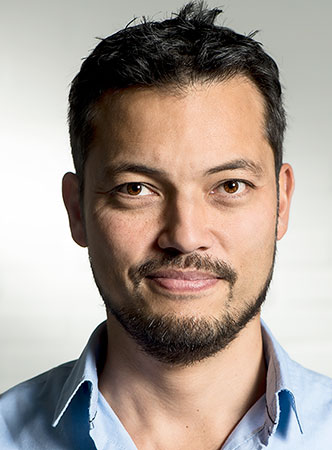Professor Leif Katsuo Oxenløwe from
DTU Fotonik, who will soon be heading up a basic research centre, believes there is no place for secrecy in research. According to him, collaboration around the world is the way to go.
Shortly before lunch on the very first day of October, Professor Leif Katsuo Oxenløwe received a phone call. He was on his way to a meeting and didn’t recognize the number in the illuminated display. Nevertheless, he took the time to answer it. It transpired that the call was from the Danish National Research Foundation, informing him that he had been selected to receive up to DKK 59 million to help him complete his dream project. When Professor Leif Oxenløwe ended the call, he had been handed a Basic Research Centre—also called a Centre of Excellence. The whole transaction had taken just a few minutes. The following week, the Danish newspaper Politiken named him one of ‘Denmark’s next superstars in the research firmament’.
“It’s all happening very quickly,” relates the 42-year-old professor with reference to his career, when DTU Avisen meets up with him. And it is highly appropriate that things should be moving so fast, because when he’s not tearing up the asphalt on his motorbike, Professor Oxenløwe devotes himself to the study of ultra-fast communication—Internet speeds that most people can barely comprehend. Downloading a full-length feature film in a fifth of a millisecond, for example. His research group, which currently counts 20–25 members, transmits terabit-size data signals by laser light and through fibre-optic cables in less than a blink of an eye.
His research is not centred exclusively on speed, however, as energy efficiency is another focus area. The reason for this is that today, it takes roughly the same amount of energy to run about 50 Google searches as it does to heat a cup of coffee, and the Internet currently accounts for more than two per cent of global man-made carbon emissions—the same as the aeronautical industry. However, this industry is not growing by 50 per cent annually, as the Internet is, so energy-efficient data transmission is set to be one of the greatest challenges of the future, as Professor Leif Oxenløwe explains.
His present team already holds the world record for transmitting the highest number of bits using a single laser, having achieved the staggering speed of 43 terabits per second. In this way, they succeeded in shaving off hundreds of energy-hungry lasers.
"Research benefits from us sharing, saying ‘you have something I can use, and I have something you can use’. I was brought up with the mentality that what matters is the result, not the individual researcher."
Leif Katsuo Oxenløwe

What’s mine is yours
Buried fibre-optic cables criss-cross the planet, ensuring that data can be transported between all areas of the world and thus serving as ‘subterranean motorway tunnels’ for file sharing, photo downloads and chats.
To start with, these cables were laid exclusively along the major lines of communication—across the Atlantic Ocean, for example—but connections now exist between major towns and cities around the world, creating what is literally a worldwide web. This is the network Professor Leif Oxenløwe’s Centre of Excellence—Silicon Photonics for Optical Communications (SPOC)—is tasked with improving, an assignment that the new head of centre emphasizes will primarily be tackled through collaboration.
“The centre will have seven international partners, and if it were up to me I’d invite many more to join us.”
As he sees it, the open guest list is paramount because no-one will gain anything by ‘going it alone’. As a young physics student at the University of Copenhagen in the 1990s, he was raised on Niels Bohr’s ideas of an open world. Twenty years later, he remains a proponent of the attitude that we stand to gain more from our thoughts by sharing them than by keeping them to ourselves.
“Research benefits from us sharing, saying ‘you have something I can use, and I have something you can use’. I was brought up with the mentality that what matters is the result, not the individual researcher. If the goal is to reduce the Internet’s energy consumption, then we will surely reach it more quickly if we share our results freely and openly.”
This mindset permeates the entire research group. When the group beat the world record for transmitting the most data with a single laser, they did so on equipment they had borrowed free of charge from the Japanese telecoms company NTT. They have also been given access to devices by a research centre in Australia. In return, they have helped these other centres and sent people and skills to various locations around the world.
Negative competition
Unfortunately, this is far from the default attitude in the world of research today, which Professor Leif Oxenløwe terms ‘a game’.
“Research can be competitive in a destructive manner. Many people still think it is important to cling to good results on their own. It’s a question of publishing your results first, which is why people are naturally wary of sharing their knowledge,” he says, making no secret of the fact that he cannot see how egoism is the way forward for research.
“Thinking that you can solve the problem of energy-efficiency in optical communication all on your own ... Well, you should never say never, but ...” he continues, letting the sentence trail off.
Competition must not develop into a bone of contention between researchers. World records, on the other hand, are excellent motivators, he relates. As long as there are results to be gained, the group will work hard to pursue them.
“It’s time to buckle up,” says Professor Oxenløwe expectantly as one of his concluding remarks. He is referring to the development of the Internet, although you sense he could just as well have said it to his reflection in the mirror. Because things are moving very quickly indeed for the young professor. Sort of like when you download a film in just a fifth of a millisecond.
Portrait in DTUavisen no. 9, November 2014.

Professor Leif Katsuo Oxenløwe lives in Hillerød with his wife and three children aged six, eight and eleven. His middle name was given to him by his Japanese mother.
2014: Appointed professor and awarded the Sapere Aude (Advanced Grant) project by the Danish Council For Independent Research (DFF).
2009: Appointed Professor with special assignments and awarded the European Research Council (ERC) Starter Grant.
2002–2007: Postdoc, Assistant Professor and Associate Professor at DTU Fotonik.
2002: PhD in Optical Communication at DTU.
1998: Graduated in physics from the University of Copenhagen.